How Long After Painting Can I Sleep in the Room?
Author: Rick Worst | Editor: Omar Alonso
Review & Research: Jen Worst & Chris Miller

Are you painting your bedroom? A fresh coat of paint can bring life to the room, but it can also cost you your health if you spend too much time in it right after you finish painting. How long after painting can I sleep in the room safely without the threat of incurring damage to my health?
The VOCs (Volatile Organic Compounds) created as the paint dries can create several adverse effects if you have overexposure to them. So it's a valid question, and we'll now explore the full the answer.
How Long Does It Take Paint to Fully Dry?
The rate at which paint dries depends on factors like the type of paint you use and the room's ambient temperature and humidity levels. Oil paints "cure" (a fancy word for drying completely) slower than latex paints. So, if you want the fastest drying time, it's better to go with a latex-based paint for the job.
If the Relative Humidity (RH) in the room is too high, then the paint won't be able to cure fully due to too much moisture being present in the room. Likewise, if the room is cold, it's going to take a long time for the paint to reach a full cure.
The ideal temperature for dying paint is 60 °F, and the ideal humidity is below 60%. At these levels, fresh paint takes roughly an hour to feel dry to the touch and about four hours to be dry enough for a second coat.
Oil-based paints take around eight hours to feel dry to the touch and 24 hours to be dry enough for a second coat (at 60 °F ambient room temperature and 60% RH). Typically, you'll use latex paint in bedrooms, lounges/ dining rooms, while oil-based paints are the better choice for kitchens and bathrooms.
While you're painting and after you finish, it's best practice to leave all doors and windows open to allow optimal airflow through the room to fast-track the drying process and remove any vapors as the paint dries and the VOCs gas off.
How Long After Painting Can I Sleep in the Room Safely?
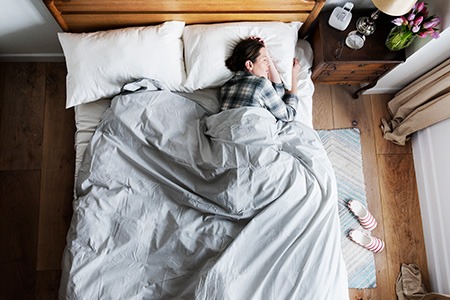
For latex paints, you'll need to wait at least four hours for it to be safe to sleep in the room, and around 24 hours for oil-based paints.
If the room has any "paint smell" to it, it means there are VOCs present, and it's not safe to sleep in the room yet. A good rule of thumb is to wait two hours after you can no longer smell any paint in the room before sleeping in it.
What are the Harmful Effects of Paint Fumes?
As mentioned, all brands and types of paint contain "Volatile Organic Compounds" (VOCs). VOCs are dangerous to your health if you breathe them in large quantities, such as when sleeping in a room overnight with VOCs present in the space.
Overexposure to VOCs can have serious health effects, including the following:
- Irritation in the throat, eyes, and sinus
- Headache & nausea
- Kidney and liver damage
- Adverse interactions with the nervous system
VOCs are carcinogens, so they can also accelerate the presence of cancer in some individuals. However, issues with cancer and problems with the kidneys, liver, and nervous system only appear after continuous exposure at high levels. It's doubtful you'll experience these effects from sleeping in a freshly painted room, even if you breathe in VOCs all night.
What Happens if You Sleep in a Freshly Painted Room? (Health Risks)
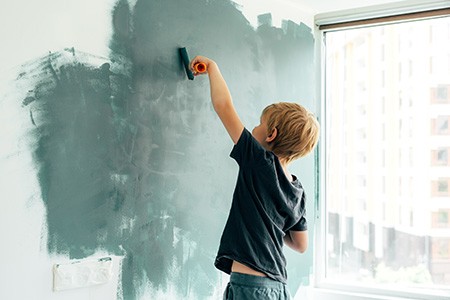
Despite the presence of VOCs being minimal in painted rooms, especially after the paint is dry to the touch and the room is ventilated, you can experience some health issues involved with breathing them in while you sleep.
So can you sleep in a freshly painted room? Absolutely not. Here are the common side effects people experience from sleeping in rooms with high levels of VOCs in the air.
Allergic Reactions
All paints, even water-based and latex paints, contain VOCs (except zero-VOC types, which we'll discuss in a minute). Breathing in the VOCs emitted by the paint as it "gasses off" can cause people with allergies to experience adverse reactions.
People with allergies might find they develop a headache, experience tingling or itching of the skin, red, watery, and itchy eyes, and a scratchy throat or cough. They may also break out into hives or rash or experience a mild form of conjunctivitis (pink eye).
Nervous System Damage
The VOCs present in oil-based paints are much more dangerous than those in latex paints, and they stick around longer since the paint takes longer to gas off. Extended exposure to VOCs in oil-based paints may cause severe adverse interactions with the central nervous system (CNS).
As you breathe in the VOCs, they dissolve in the bloodstream alongside oxygen, spreading throughout the body and interacting with the brain and other organs like the kidneys and liver. So perhaps the answer to how long after painting can I sleep in the room is as long as you can muster waiting, within reason.
If you wake up after your sleep to find you feel confused, you have trouble coordinating your actions, and you feel a headache or weakness, you're dealing with overexposure and issues with the nervous system.
Organ Damage
Extensive exposure to VOCs in the paint can also damage your organs. As mentioned, the VOCs enter your bloodstream as you breathe them in. The blood carries the VOCs around your body, interacting with all your organs.
Since the kidneys and liver are the primary filters of toxins in the body, they usually feel the effects of VOC overexposure first. While painting a room isn't enough to create these extensive conditions providing prolonged exposure to VOCs, you might experience these issuers if you're painting your house for days on end or if you're a contractor and you have continuous exposure to point fumes in your work.
You might notice signs like pain in your right side as the liver turns toxic, and your skin and the whites of your eyes turn yellow (a sign of "jaundice). Your urine might turn dark in color as your kidneys become affected by the VOCs.
What Are the VOC Levels in Latex & Oil Paints?
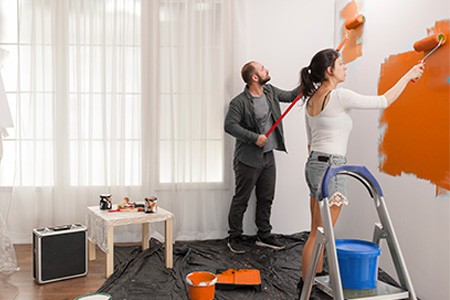
Let’s look at the common types of paint used in interior design and a couple types of paint that could speed up the process for you:
Latex Paint
Latex paints take between two to eight hours to reach a full cure. Depending on environmental conditions and the type of paint used, it could take up to two weeks before the paint stops emitting VOCs completely. Typically, latex-based paint has 150 grams per liter of VOCs. That's about half as much as oil-based paints.
Low-VOC Paint
Low-VOCV latex paints are much safer for painting bedrooms than oil-based paints or regular latex paints. They contain about a third of the VOCs as standard latex paints, with 50 grams of VOCs per liter.
Zero-VOC Paint
Latex paints have between zero to five grams of VOCs per liter, making them the ideal choice for painting bedrooms and other living spaces in the house. They dry fast, and you can usually sleep in a room painted with these zero-VOC products the first night after painting. They're the best choice for people with allergies and those sensitive to chemical exposure.
Oil-Based Paints
Oil-based paints have a strong odor due to the high levels of alkyd in the paint. Typically, oil-based paints have around 350 grams of VOCs per liter and take approximately eight to 24 hours to dry.
FAQ’s Concerning When It’s Safe to Sleep in a Room You Just Painted
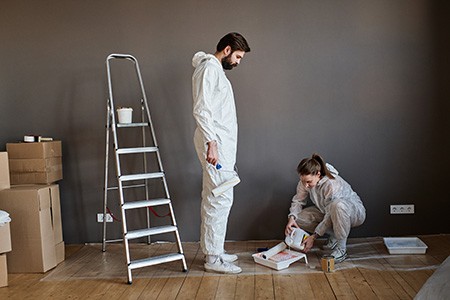
When is it safe to sleep in a room after painting? That’s the question, but that immediately leads to a handful of other common questions. Let’s deal with those now.
How Long Should You Air Out a Bedroom After Painting?
While sleeping in a room between eight to 24 hours after painting is safe, it's best to avoid it for two to three days if you can. This strategy ensures you have enough time to allow the paint to reach a full cure and remove any lingering VOCs in the room.
How Can You Speed Up Drying After Painting a Room?
Increaser the ventilation to the space to allow the VOCs created when the paint dries to escape the room. You can run fans to assist with a faster drying time. Turn the fans on when the paint is touch dry. The same works for getting rid of a gas smell in your house and any other odorous situations.
What Are the Long-Term Health Effects of Paint Inhalation?
Long-term overexposure to VOCs can cause health issues such as headaches, nausea, irritation to the skin, eyes, and sinuses, and allergic reactions. Continuous overexposure to VOCs found in paint can create severe health complications like asthma, nervous system damage, liver, and kidney problems, and even cancer.
What Is the Best Time of Day to Paint a Room?
It's best to paint rooms in the early morning. This strategy gives you enough time to ventilate the area before sleeping that night. Open all the doors and windows to ensure optimal airflow into the painted space. In these optimal cases, sometimes the answer to can you sleep in a room after painting is yes, but play it safe if ever in doubt.
Key Takeaways Regarding Sleeping in a Recently Painted Room
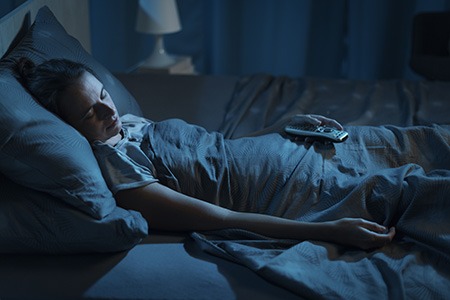
Let’s summarize the main points from above again in quick list form:
- Volatile Organic Compounds (VOCs) found in paint gas off as the paint dries. These VOCs enter the air and dissolve in your bloodstream as you breathe them in.
- Overexposure to VOCs can cause severe adverse health effects.
- Wait at least four hours before sleeping in rooms painted with latex paints and 24 hours before sleeping in a room painted with oil paints. These are the wait-times suggested by professional house painters, so please take heed.
- If you notice any signs of overexposure to VOCs listed in this post, consult a medical professional immediately.
The longer you can wait, the better. Four hours is the minimum for latex and 24 hours for oil, but if you can still smell the paint afterwards, allow another day to pass while you continue to ventilate the room.
So, How Long After Painting Can I Sleep in the Room?
As mentioned, four hours is your minimum wait time for latex paint and 24 hours for oil paint, though I recommend going well past the minimum since there’s zero rush when your bodily safety is at stake.
The longer you can wait (reasonably so, I mean), the better, while you continue to ventilate until you can’t smell the paint any more. So, how long after painting can I sleep in the room? You’ll have to check the type of paint you used, and then decide how patient you want to be.



